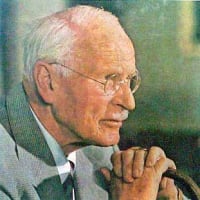
"..We see the same theme operating at times in the psychotherapeutic relationship. Perhaps a negative or rebellious reaction has emerged towards the analyst. Such a reaction may be accompanied by a great deal of guilt and anxiety, particularly if the analyst is carrying the projection of archetypal authority. To express a negative reaction with genuine affect in these circumstances is felt to be very similar to the crime against the gods. It will seem to be a dangerous act of inflation certain to bring retribution. But at some point unless the forbidden fruit is eaten, unless one dares to steal the fire from the gods, he will remain stuck in a dependent transference and development will not proceed."
Edward Edinger Ego and Archetype
「...心理療法的な関係においても、同じようなテーマが作用することがあります。おそらく、分析者に対して否定的または反抗的な反応が現れているのでしょう。このような反応は、特に分析者が元型的な権威の投影を持っている場合には、大きな罪悪感と不安を伴うかもしれません。このような状況で純粋な感情をもって否定的な反応を表現することは、神々に対する罪と非常に似ていると感じられます。それは、報復を確実にもたらす危険な煽り行為のように思えるでしょう。しかし、どこかの時点で禁断の果実を食べない限り、あえて神々から火を盗まない限り、依存的な転移に留まり、発達は進まないのである。"
エドワード・エジンガー 自我と元型
*Adam and Prometheus*(アダムとプロメテウス
オリジナルのインフレーションの状態の後のことは、神話の中で生き生きと提示されています。その好例がエデンの園の神話で、これは著しく人間の堕落と呼ばれています。この神話についてユングはこう書いている。
堕落の伝説には深い教義がある。それは、自我意識の解放がルシファー的な行為であるというおぼろげな予感の表現である。人間の歴史は、最初から、劣等感と傲慢さとの葛藤で成り立っている」17。
創世記の記述によると、神は人間をエデンの園に入れてこう言った。「しかし、善悪の知識の木は食べてはならない。食べた日に死ぬからである」。その後、アダムの肋骨からエバが創造され、エバが蛇に誘惑されて、「あなたは死ぬことはありません。神は、あなたがその実を食べるとき、あなたの目が開かれ、神のようになり、善悪を知るようになることをご存じだからです。" と告げました。そこで、アダムとイブはその実を食べました。「二人はいちじくの葉を縫い合わせてエプロンを作った。神は彼らの不従順を発見し、彼らに呪いをかけたが、それに続いて次のような重要な言葉がある。「そこで、神は男をエデンの園から追い出し、自分が取られた土地を耕させた。神は男を追い出し、エデンの園の東側にケルビムと縦横に回る炎の剣を置いて、命の木への道を守った」18。
これは、私たちの文化的伝統のヘブライ語部門の最初に位置する神話であり、心理的な意味を豊富に含んでいます。エデンの園は、ギリシャの黄金時代の神話やプラトンの丸い人間の原型に匹敵する。エデンの園は、4つの川が流れ、中央に命の木がある曼荼羅のある特徴を持っています(プレート1)。曼荼羅・庭園は自己のイメージであり、この場合、自我が自然や神と元々一体であることを表している。それは、自己と一体化した最初の、無意識の、動物的な状態である。意識がまだ現れていないので、葛藤がなく、パラダイムである。自我は、自己の子宮の中に入っています(写真3)。
本来の全体性を示すもう一つの特徴は、アダムからイヴが創造されたことです。アダムがもともと両性具有であったことは明らかで、そうでなければアダムから女性が作られることはありません。ここには、オリジナルの男性が間違いなく両性具有であったという初期の神話の名残があるのかもしれません。この初期の神話は、間違いなく、精神の女性的要素を低く評価し、アダムの肋骨に過ぎないとしたヘブライ人の一方的な家父長制の態度によって修正されたものです。アダムが男性的要素と女性的要素に分離したのは、アダムが楽園の庭から分離したのと平行して、同等のプロセスである。いずれにしても、人間は本来の全体性から切り離され、疎外されることになります。
誘惑と堕落のドラマは、元々の受動的な膨らみの状態が、特定の行為のための能動的な膨らみに変わるときに始まります。蛇は、「この木の実を食べれば、目が開かれて神のようになれる」という言葉を使って、誘惑します。そこで、木の実を食べ、必然的な結果が展開されます。アダムとイブが神のようになりたいという願望を敢えて行動に移したことがすべての始まりである。
この神話では、意識の誕生を、人間を神や本来の前意識的な全体性から疎外する犯罪として描いている。果実は明らかに意識を象徴している。それは善悪を知る木の実であり、意識の特徴である相反するものへの認識をもたらすことを意味している。このように、この神話とそれに基づく神学的教義によれば、意識は原罪であり、原初のハイブリであり、人間性におけるすべての悪の根本原因である。しかし、他の人々はこれとは異なる理解をしている。グノーシス派の一派であるオフィテスは、蛇を崇拝していました。彼らは、現代の心理学と基本的に同じ考え方をしていました。彼らにとって蛇は、エデンの園を創造し、人間を無知のままにしておくデミウルゲへの束縛からの救済を象徴する精神的原理を表していました。蛇は善であり、ヤハウェは悪であると考えられていました。心理学的には、蛇は「グノーシス(知識)」の原理であり、「知識」や「出現する意識」を意味しています。また、蛇の誘惑は人間の自己実現への衝動を表し、個性化の原理を象徴している。グノーシス派の中には、エデンの園の蛇をキリストと同一視する宗派もあった。
*Adam and Prometheus*
What follows the state of original inflation is presented vividly in mythology. An excellent example is the Garden of Eden myth which, significantly is called the fall of man. About this myth Jung writes:
There is deep doctrine in the legend of the Fall; it is the expression of a dim presentiment that the emancipation of ego consciousness was a Luciferian deed. Man’s whole history consists from the very beginning in a conflict between his feeling of inferiority and his arrogance.17
According to the account in Genesis, God put man in the garden of Eden saying: “You may freely eat of every tree in the garden; but of the tree of the knowledge of good and evil you shall not eat, for in the day that you eat of it you shall die.” Then follows the creation of Eve from Adam’s rib and Eve’s temptation by the serpent who told her “You will not die. For God knows that when you eat of it your eyes will be opened, and you will be like God, knowing good and evil.” So Adam and Eve ate the fruit. “Then the eyes of both were opened and they knew that they were naked; and they sewed fig leaves together and made themselves aprons.” God discovered their disobedience and put the curse upon them following which are these significant words. “Then the Lord God said, ‘Behold, the man has become like one of us, knowing good and evil; and now, lest he put forth his hand and take also of the tree of life, and eat, and live for ever’-therefore the Lord God sent him forth from the garden of Eden to till the ground from which he was taken. He drove out the man; and at the east of the garden of Eden he placed the cherubim, and a flaming sword which turned every way, to guard the way to the tree of life.”18
This is the myth which stands at the beginning of the Hebrew branch of our cultural tradition and it is rich in psychological meaning. The Garden of Eden is comparable to the Greek myth of the golden age and Plato’s original round man. The Garden of Eden has certain features of a mandala with four rivers flowing from it and the tree of life in its center (Plate 1). The mandala-garden is an image of the Self, in this case representing the ego’s original oneness with nature and deity. It is the initial, unconscious, animal state of being at one with one’s Self. It is paradisal because consciousness has not yet appeared and hence there is no conflict. The ego is contained in the womb of the Self (Picture 3).
Another feature indicating original wholeness is the creation of Eve out of Adam. Clearly, Adam was originally hermaphroditic, otherwise a woman could not have been made from him. It is likely that we have here vestiges of an earlier myth in which the original man was definitely hermaphroditic. Undoubtedly this earlier myth was modified by the one-sided patriarchal attitude of the Hebrews which depreciated the feminine component of the psyche, reducing it to no more than a rib of Adam. Adam’s separation into masculine and feminine components is a process which is parallel and equivalent to his separation from the paradise garden. In any case the effect is that man becomes separated and alienated from his original wholeness.
The drama of temptation and fall begins when the original state of passive inflation turns into the active inflation of a specific deed. The serpent’s whole approach and appeal is expressed in inflationary terms-when you eat of this fruit, your eyes will be opened and you will be like God. So the fruit of the tree is eaten and the inevitable consequences unfold. It all begins because Adam and Eve dare to act on their desire to be like God.
The myth depicts the birth of consciousness as a crime which alienates man from God and from his original preconscious wholeness. The fruit is clearly symbolical of consciousness. It is the fruit of the tree of the knowledge of good and evil, which means that it brings awareness of the opposites, the specific feature of consciousness. Thus, according to this myth and the theological doctrines that rest on it, consciousness is the original sin, the original hybris, and the root cause of all evil in human nature. However, others have understood it differently. The Ophites, a Gnostic sect, worshipped the serpent. They had essentially the same view as modern psychology. To them the serpent represented the spiritual principle symbolizing redemption from bondage to the demiurge that created the Garden of Eden and would keep man in ignorance. The serpent was considered good and Yahweh bad. Psychologically the serpent is the principle of gnosis, knowledge or emerging consciousness. The serpent’s temptation represents the urge to selfrealization in man and symbolizes the principle of individuation. Some Gnostic sects even identified the serpent in the Garden of Eden with Christ.
禁断の果実を食べることは、自己と無意識に一体化した永遠の状態(心のない動物の状態)から、空間と時間の中での現実の意識的な生活への移行を意味しています。つまり、この神話は自我の誕生を象徴しています。この誕生のプロセスの効果は、自我をその起源から疎外することです。そして自我は、苦しみ、葛藤、不確実性の世界へと移動していきます。これでは、意識を高めるための一歩を踏み出せないのも無理はありません(写真4)。
意識の「落下」のもう一つの特徴は、アダムとイブが自分の裸を意識したことです。性や本能が突然タブーになり、恥ずかしい対象になります。精神的な原理としての意識は、自然で本能的な動物の機能に対抗するものを生み出しました。意識の誕生と同時に、人間の精神には二重性、解離、抑圧が生まれました。つまり、意識がそれ自体として存在するためには、少なくとも最初は無意識と拮抗していなければならないということである。この洞察は、子供の頃に性的、本能的な抑圧を受けさえしなければ、人間の人格は完全で健全なものになるとするユートピア的な心理学の理論がすべて間違っていることを教えている。心理的な発展の生得的で必要な段階では、意識と無意識、精神と自然という相反するものの二極化が必要である。
しかし、アダムとイブが現実の世界で悲しげに苦しい生活をし、眉間に汗をかいてパンを稼ぎ、苦しみながら子供を産む姿を残したままでは、堕落の神話の調査は完了しない。エデンの園には、善悪を知る木だけでなく、命の木もありました。そして、ヤハウェは人間が2本目の木を発見し、その恵みを受けることに不安を感じておられました。これは何を意味するのでしょうか?ギンズバーグの『ユダヤ人の伝説』には、命の木にまつわる興味深い伝説があり、それがこの問題を考えるヒントになります。
楽園には、命の木と知識の木があり、知識の木は命の木の周りに垣根を作っている。知識の木を通って自分の道を切り開いた者だけが、命の木に近づくことができる。命の木は非常に巨大で、人間が幹の直径に等しい距離を横断するのに500年かかると言われており、その枝の冠で覆われた空間も同様に広大である。その下からは、地球全体を灌漑する水が流れ出て、ガンジス川、ナイル川、チグリス川、ユーフラテス川の4つの流れに分かれている19。
神話の周辺で育まれた伝説は、元の物語では省略されていた部分を増幅したり、精巧にしたりすることが多く、あたかも集団心理が全体像を把握し、象徴的な意味を明らかにする必要があるかのようです。引用した伝説もそのようなものだと思います。聖書の記述では、知識の木と生命の木の関係について、かなり曖昧な絵が描かれている。この伝説では、より明確で納得のいくイメージが示されている。この伝説では、生命の木は、世界樹ユグドラシルに類似したオムファロス(世界のへそ)として描かれています。聖書には、命の木の実が不死をもたらすと書かれています。アダムとエバは、堕落する前は不死身でしたが、無意識でもありました。堕落後に命の木の実を食べることができれば、意識と不死の両方を手に入れたことになります。ヤハウェは、自分の領域が侵害されることに反対し、炎の剣を持ったケルビムを障害物として設置します。しかし、引用したユダヤ人の伝説は、命の木を見つけるためのヒントを与えてくれます。それは、善悪の知識の木という生け垣のような木を通り抜けて、命の木にたどり着くというものです。つまり、蛇の誘惑を繰り返し受け、知識の果実を繰り返し食べて、命の木への道を切り開くのです。つまり、失われた全体性の回復は、意識の果実を存分に味わい、同化することによってのみ達成されるのである。
堕落の神話は、無意識から意識が生まれた当初のパターンとプロセスだけでなく、人が意識を新たに増やすたびに何らかの形で通過するプロセスを表現しています。アダムとイブをただの恥ずべき果樹園泥棒として描くのは一方的だと、私はオフィース人と同じように考えています。彼らの行動は英雄的なものであるとも言えます。彼らは従順という受動的な快適さを犠牲にして、より大きな意識を持ったのです。意識が快適さよりも大きな価値を持つことを認めるならば、蛇は長い目で見れば確かに利益者であることを証明しています。
Eating the forbidden fruit marks the transition from the eternal state of unconscious oneness with the Self (the mindless, animal state) to a real, conscious life in space and time. In short, the myth symbolizes the birth of the ego. The effect of this birth process is to alienate the ego from its origins. It now moves into a world of suffering, conflict and uncertainty. No wonder we are reluctant to take the step to greater consciousness (Picture 4).
Another feature of the “fall” into consciousness is that Adam and Eve became aware of their nakedness. Sexuality and the instincts in general suddenly become taboo and objects of shame. Consciousness as a spiritual principle has created a counterpole to natural, instinctive animal function. Duality, dissociation and repression have been born in the human psyche simultaneously with the birth of consciousness. This means simply that consciousness in order to exist in its own right must, initially at least, be antagonistic to the unconscious. This insight teaches us that all utopian psychological theories which assume that the human personality can be whole and healthy if only it is not subject to sexual and instinctual repressions in childhood are wrong. The innate and necessary stages of psychic development require a polarization of the opposites, conscious vs unconscious, spirit vs. nature.
But our survey of the myth of the fall is not complete if we leave it with the image of Adam and Eve sadly taking up their hard life in the world of reality, earning their bread by the sweat of their brow and bringing forth children in pain. There were two trees in the garden of Eden, not only the tree of knowledge of good and evil, but also the tree of life. And indeed Yahweh demonstrated some anxiety that man might discover the second tree and partake of its blessings. What can this mean? There is an interesting legend concerning the tree of life reported in Ginsberg’s Legends of the Jews which offers some insight on the question:
In paradise stands the tree of life and the tree of knowledge, the latter forming a hedge about the former. Only he who has cleared a path for himself through the tree of knowledge can come close to the tree of life which is so huge that it would take a man five hundred years to traverse a distance equal to the diameter of the trunk, and no less vast is the space shaded by its crown of branches. From beneath flows forth the water that irrigates the whole earth, parting thence into four streams, the Ganges, the Nile, the Tigris, and the Euphrates.19
Legends growing up around a myth often amplify and elaborate aspects left out in the original story, as though the collective psyche needed to round out the picture and clarify the full symbolic meaning. Such, I think, is the case with the legend quoted. The Biblical account gives a quite ambiguous picture concerning the relation between the tree of knowledge and the tree of life. This legend presents a much clearer and satisfying image. The legend presents the tree of life as an omphalos or world navel, analogous to the world tree Yggdrasil. The Bible tells us that the fruit of the tree of life conveys immortality. Adam and Eve were immortal before the fall, but they were also unconscious. If they can eat the fruit of the tree of life after the fall, they have achieved both consciousness and immortality. Yahweh is opposed to any such infringement on his realm and sets up the cherubim with the flaming sword as an obstacle. However the Jewish legend quoted gives us some hint as to how the tree of life can be found. It can be reached by clearing a path through the hedge-like tree of the knowledge of good and evil. That is, one must repeatedly accept the temptation of the serpent, repeatedly eat the fruit of knowledge and in that way eat his way through to the tree of life. In other words, the recovery of our lost wholeness can only be achieved by tasting and assimilating the fruits of consciousness to the full.
The myth of the fall expresses a pattern and a process not just of the original birth of consciousness out of the unconscious, but also of the process that one goes through in one form or another with every new increment of consciousness. I believe with the Ophites that it is onesided to depict Adam and Eve just as shameful orchard thieves. Their action could equally be described as an heroic one. They sacrifice the passive comfort of obedience for greater consciousness. The serpent does indeed prove to be a benefactor in the long run if we grant consciousness a greater value than comfort.



















